Vol 4 No. 1 TROPIC LIGHTNING NEWS January 6, 1969
Index
| Unit Page | Unit Page | Unit Page | Unit Page |
| 1 Bde 3 | 2/12 Photo 3 | 3/22 1 | 545 MP 5 |
| 1 Bde 7 | 2/14 Photo 1 | 3/22 3 | 545 MP Photo 5 |
| 1/27 6 | 2/14 6 | 3/22 6 | 7/11 1 |
| 1/8 2 | 2/27 1 | 4/23 Photo 1 | 7/11 3 |
| 1/8 Photo 2 | 2/27 Photo 6 | 4/23 3 | 7/11 8 |
| 125th Signal 4 | 25th MP 5 | 4/9 3 | 7/11 Photos 8 |
| 125h Signal Photos 4 | 25th MP Photos 5 | 4/9 Photo 3 | MACV Tm. 90 3 |
Cong,
NVA Assaults On Wolfhounds
Smashed At Night Laager Position
By SP4 Karl Karlgaard
CU
CHI -
In a well-coordinated operation over a five-and-a-half day period, Wolfhounds of
the 2d Battalion, 27th Infantry, repelled two VC-NVA night assaults and made
several dramatic encounters killing 51 enemy.
Early intelligence reports
revealed large concentrations of enemy troops in the area. Early in the morning, the Wolfhounds moved into the area to
establish laager positions and search out the enemy.
Alerted by increased
sightings and ambush patrol action, the soldiers of Alpha Company battened down
their laager site some six miles south-southwest of Go Dau Ha shortly before the
VC-NVA forces launched their first night assault.
Alpha’s first platoon
spotted enemy movement outside the wire about 5 a.m.
The men opened up with claymores, automatic weapons and mortar fire,
blasting the enemy who had advanced to within 20 meters of the wire.
“We could hear them
screaming and yelling,” reported platoon Sergeant Sam Spain.
The company’s Vietnamese interpreter stated that one of the enemy kept
shouting, “Bring up the B-40, bring up the B-40.”
The
battle lasted until the enemy retreated at first light.
A sweep of the area the following day revealed 14 enemy bodies and
numerous blood trails.”
Among the weapons captured
were a Chicom light machine gun, four AK-47s, one B-40 rocket launcher and
numerous documents.
Throughout the following day
the Wolfhounds swept the area for the enemy and further signs of activity.
Then again on the night of the 27th, they dug in before the enemy struck
the night location at 1:00 a.m.
Private First Class Terry
Rosebury of Walla Walla, Wash., recalled, “We first saw movement shortly after
it got dark. Groups of five to ten
NVA could be seen moving at different places 400 to 500 meters from the
perimeter.”
Artillery called in on the
enemy scattered the NVA but failed to drive them away. The 2d Brigade soldiers kept 100 per cent alert and called in
more artillery on fresh sightings.
“We kept hearing movement
on our side of the perimeter,” said 2d Platoon Leader First Lieutenant Robert
Nebiker, of Maywood, N.J., “but couldn’t see anything because of the tall
plants.”
They soon found out how
close the enemy was, however as two trip flares popped about forty meters from
the perimeter.
The Tropic Lightning
troopers immediately engaged the enemy and found they were up against a large
force as Charlie returned their fire.
During this time, several
NVA soldiers fought their way through the perimeter but were quickly killed by
the Wolfhounds.
Gunship teams and spooky
arrived and added their firepower to that of the Fire Brigade soldiers and soon
established fire superiority.
Shortly thereafter the enemy
withdrew leaving much equipment and many weapons.
For two days following the
final attack, the soldiers pursued enemy trails and signs of activity, engaging
small forces and detaining several suspects before moving into another area.
The Wolfhound body count
added a considerable number to the 67 enemy killed within the 2d Brigade in the
same period of time.
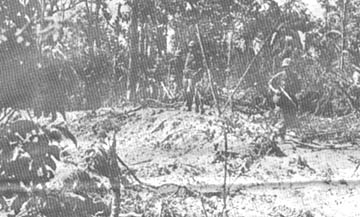 |
| ON THE HUNT – Soldiers of Bravo Company, 4th Battalion (Mechanized), 23rd Infantry, skirt a bomb crater while in search of an elusive enemy. Moments after this picture was taken a large bunker was discovered by the Tropic Lightning Troopers. (PHOTO BY SP4 ROGER WELT) |
Tomahawks
Play Host To Pilots
By
SGT Herb Burdett
TAY NINH
- The officers and men of Tropic Lightning’s 3d Battalion, 22d Infantry,
played host to a couple of Air Force officers from Guam at Fire Support Base
Washington northwest of Tay Ninh.
Captain George E. Upton of
New Paltz, N.Y., a B-52 radar operator, and Captain Robert E Christensen, an
aircraft commander, left their homes in the wild blue yonder to spend a few days
with the foot soldiers.
The two captains are members
of a bomber crew selected to participate in an exchange program in which Army
and Air Force officers switch places just to see what the other half is really
like, and to understand each other’s problems.
Upon their arrival in Tay
Ninh both officers were greeted and briefed by Colonel Robert L. Fair of
Alexandria, Va., the commanding officer of the 1st Brigade.
They were then escorted to
Fire Support Base Buell by Captain Larry D. Graves of Arvada Colo., the 1st
Brigade’s S-3 air officer. At
Buell they met Lieutenant Colonel Alexander H. Hunt of Wealder, Tex., the
commanding officer of the 3d Battalion, 22d Infantry.
Taking off in Hunt’s
command and control helicopter, they watched while Company A of the 3d
Battalion, 22d Infantry, was inserted into the jungles and rice paddies north of
Tay Ninh. Landing at FSB
Washington, the two airmen outfitted themselves with M16s, ammunition and
canteens then joined Alpha as it made its second insertion into the jungle.
After being retrieved by
Huey copters and dropped off outside the wire at FSB Washington, the Air Force
officers made their way to Hunt’s command tent.
Soon Christensen, Hunt,
Blackmon, and Upton were sitting around the command tent swapping stories.
Much of the conversation centered around the new working relationship
among the armed services.
Soon it was dark enough for
the artillerymen to start their harassment and interdiction fires.
Captain Kenneth Coy of Eureka, Ill., commanding officer of A Battery, 7th
Battalion 11th Artillery, showed the duo around his battery.
Alpha’s mortar crews were
also starting their night’s firing at intelligence targets, and took time to
show the Air Force how to work the 81mm mortars.
The two captains took turns dropping rounds down the mortar tubes.
Later there was a
demonstration of the protective fire that can be dished out around a Fire
Support Base. Upton and Christensen took their places on the line firing M16s
and an M60 machine gun.
The following morning the
two airmen left the 25th Division’s operational area.
Hunt presented each with a plaque as a remembrance of the visit with the
Regulars. As they were leaving both
emphasized that they better understood the infantry’s role in the war.
They only had one regret, and that was they didn’t get to see a B-52
strike while they were flying around the area.
“Perhaps we will next time around,” said Upton.
“Maybe we’ll even get to go on ambush.”
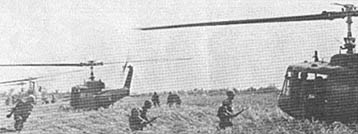 |
| EVERY SECOND COUNTS - Second Brigade soldiers of the 2d Battalion, 14th Infantry Golden Dragons, rush to their choppers during heliborne operations near Duc Hoa. (PHOTO BY SP4 E.R. JAMES) |
Page 2 TROPIC LIGHTNING NEWS January 6, 1969
Decorated
| ARMY
COMMENDATION MEDAL
(HEROISM) |
|
| CPT
Jerry J. Boyington, B Co, 25th Avn Bn CPT Michael Byrne, D Co, 2d Bn, 12th Inf CPT Edwin Fu11er, HHB, 7th Bn, 11th Arty CPT Richard S. Humphrey, HHB, 1st Bn, 8th Arty 1LT Steven R. Stein, B Co, 4th Bn, 9th Inf WO1 Mitchel L. Wilhelm, A Co, 25th Avn Bn WO1 Larry Steilen, A Co, 25th Avn Bn SFC Paul Gargis, HHC, 3d Bn, 22d Inf SSG Ray L. Corley, D Btry, 3d Bn, 13th Arty SSG Robert S. Correia, A Trp, 3d Sqdn, 4th Cav SGT Joe Salezar, A Co, 65th Engr Bn SGT Michael Denison, HHC, 3d Bn, 22d Inf SGT Bernard Terkevrst, C Btry, 1st Bn, 8th Arty SGT William Bangley, C Co, 3d Bn, 22d Inf SGT James Whitehead, A Btry, 3d Bn, 13th Arty SGT Paul O’Brien, Co D, 3d Bn, 22d Inf SP5 Wylie M. Blundell, A Btry, 3d Bn, 13th Arty SP5 Raymond Bustard, HHC, 2d Bn, 22d Inf SP4 George Shaffer, C Trp, 3d Sqdn, 4th Cav SP4 Roger Kinnunen, C Trp, 3d Sqdn, 4th Cav SP4 Kenneth L. Green, D Co, 2d Bn, 27th Inf SP4 Holle E. Ramaker, D Co, 2d Bn, 27th Inf SP4 Raymond J. Fredenburg, D Btry, 3d Bn, 13th Arty SP4 Jack McLemore, D Co, 3d Bn, 22d Inf SP4 Ronald Woodard, C Co, 3d Bn, 22d Inf SP4 Giles G. St Pierre, C Trp, 3d Sqdn, 4th Cav SP4 Curtis Darrisaw, D Co, 1st Bn, 27th Inf SP4 William Nash, D Co, 3d Bn, 22d Inf SP4 Robert O. Mullis, C Co, 65th Engr Bn SP4 Bradley D. Keele, A Co, 2d Bn, 14th Inf SP4 David A. Hannu, C Co, 2d Bn, 14th Inf SP4 Paul E. Land, C Co, 2d Bn, 14th Inf SP4 John W. Derr, B Co, 2d Bn, 14th Inf SP4 Charley Scott, D Co, 3d Bn, 22d Inf |
SP4
Jack E. Mosley, B Co, 25th Avn Bn SP4 Ronnie D. Brooks, C Btry, 1st Bn, 8th Arty SP4 Edward M. Carbajel, C Btry, 1st Bn, 8th Arty SP4 Dewight Oilar, D Co, 2d Bn, 12th Inf SP4 Theodore Lawlor, A Co, 2d Bn, 12th Inf SP4 Peter Henderson, B Btry, 7th Bn, 11th Arty SP4 Eloy Lazno, HHC, 2d Bn, 22d Inf SP4 Phillip Latta, A Co, lst Bn, 5th Inf SP4 Jose Huertas, B Co, 3d Bn, 22d Inf SP4 Roy Lischinsky, C Btry, 2d Bn, 77th Arty SP4 Antonio Ruiz-Montes, B Co, 2d Bn, 12th Inf SP4 Carl E. Terry, HHB, 7th Bn, 11th Arty SP4 Julio C. Perez, Co D, 3d Bn, 22d Inf SP4 Richard Greenlee, A Btry, 3d Bn, 13th Arty PFC Cloyce Light, C Co, 4th Bn, 23d Inf PFC James Rogers, A Co, 1st Bn, 5th Inf PFC Delbert Baxter, JJ HHC, 2d Bn, 22d Inf PFC Clyde M. Leatherman, C Co, 4th Bn, 23d Inf PFC William R. Teske, A Co, 2d Bn, 22d Inf PFC James Shelton, A Co, 65th Engr Bn PFC Art Lawrence, D Co, 3d Bn, 22d Inf PFC Martin Espinoza, D Co, 3d Bn, 22d Inf PFC Ron Porter, A Co, 65th Engr Bn PFC Joseph Wacker, D Co, 3d Bn, 22d Inf PFC Roland Paquin, A Co, 25th Avn Bn PFC Charles Paige, A Co, 65th Engr Bn PFC Tyrone Wiley, A Co, 65th Engr Bn PFC Billy Vansick1e, A Co, 3d Bn, 22d Inf PFC Devron Carter, A Co, 3d Bn, 22d Inf PFC Thomas Eberlein, A Co, 3d Bn, 22d Inf PFC Gregory Boyle, A Co, 2d Bn, 14th Inf PFC Donald Cook, A Co, 3d Bn, 22d Inf PVT Paul Wakefield, D Co, 3d Bn, 22d Inf |
OJT,
Class Offered To ETS Troops
A new program has been
devised to help servicemen obtain valuable skills for use after separation from
the service.
Project Transition is a
Department of Defense sponsored program to provide in-service training
opportunities for separating personnel who have not acquired a civilian-related
skill.
Persons with up to six
months remaining before their scheduled separation, and who are not going to
re-enlist, can apply for a variety of special job-training or education courses.
Army personnel who are
scheduled for release from active duty under honorable conditions, either
through retirement or completion of their term of service, are eligible to
participate.
Project Transition is
offered at 55 different CONUS installations.
Over 243 kinds of vocational
courses are offered, ranging from Accounting to X-ray repair.
You can apply prior to
separation by completing a questionnaire upon which you indicate the career you
wish to pursue and the training you desire.
Project Transition is a
CONUS program only. Take advantage of it.
Tropic Lightning Tots
The Commanding General Welcomes
The Following Tropic Lightning Tots
To The 25th Infantry Division – As
Reported By The American Red Cross.
Born To:
| December
14 SP4 John K. Wannamaker, Co. C, 1st Bn., 5th Inf., a son SP4 Donnie F. Brantly, 20th Transport Co., a son December 15 PFC James Burem, Co. B, 2d Bn., 14th Inf., a son. December 16 SP4 Murriel Lee Cook, Co. B, 36th Signal Bn., a daughter. PFC Paul F. Wilson, Co. B, 1st Bn. (Mech), 5th Inf., a daughter |
December
17 SP4 Ronald Lee, Co. A, 25th S & T Bn., a son December 18 Cpt. Terry Throckmorton, Advance Team 43, a daughter December 19 SP4 Calvin L. Casper, Co. B, 2d Bn., 27th Inf., a daughter December 20 SP4 Donald L. Plunk, HQ Co., 25th S & T Bn., a son |
Legion
To Help Veterans
The United States Army Chief
of Staff has approved a program to promote recognition of Army members returning
from Vietnam for reassignment or separation.
In this regard the American Legion is considering a proposal to serve
through its local posts as the point of contact for all local civic groups
desiring information about returning Vietnam veterans.
Under consideration is a post card form which would be
completed during out processing from USARV and air-mailed to one of the state
level American Legion organizations, which then would be referred to the local
level.
Tropic Lightning
Combat Honor Roll
 Added to the Tropic Lightning Combat Honor Roll this week is Corporal
Charles W. Blixt who distinguished himself by heroic actions on October 3, 1968
while serving as a section chief with C Battery, 1st Battalion, 8th Artillery in
the Republic of Vietnam.
Added to the Tropic Lightning Combat Honor Roll this week is Corporal
Charles W. Blixt who distinguished himself by heroic actions on October 3, 1968
while serving as a section chief with C Battery, 1st Battalion, 8th Artillery in
the Republic of Vietnam.
A numerically superior
hostile force launched a massive mortar, rocket and ground assault against Fire
Support Base Keene III. As the
hostile projectiles impacted around his position, Corporal Blixt immediately
observed the flashes from the enemy guns.
With complete disregard for
his own safety, Corporal Blixt exposed himself to a heavy volume of enemy fire
as he moved about his section, organizing his men and preparing his howitzer for
firing.
Corporal Blixt fearlessly
exposed himself to the withering enemy fire as he assumed a position that
enabled him to observe the insurgent’s movements.
Remaining at his unprotected position, Corporal Blixt adjusted his
section’s fire on the advancing enemy.
His valorous actions
contributed immeasurably to the success of the mission.
The TROPIC LIGHTNING NEWS is an authorized publication of the 25th Infantry Division. It is published weekly for all division units in the Republic of Vietnam by the Information Office, 25th Infantry Division, APO San Francisco 96225. Army News Features, Army Photo Features, Armed Forces Press Service and Armed Forces News Bureau material are used. Views and opinions expressed are not necessarily those of the Department of the Army. Printed in Tokyo, Japan, by Pacific Stars and Stripes.
MG Ellis W. Williamson . . . . Commanding General
MAJ Andrew J. Sullivan . . . Information Officer
2LT Don A. Eriksson . . . . . . Officer-in-Charge
SP4 Stephen Lochen . . . . . . Editor
SP4 Robert C. Imler . . . . . . . . Assistant Editor
SP4 Tom Quinn . . . . . . . . . . . Production Supervisor
Page 3 TROPIC LIGHTNING NEWS January 6, 1969
Direct
Commission Program Looking For Combat Leaders
In the course of the Vietnam
war, distinguished combat leaders of all ranks have emerged.
As a means of recognition for achievement and a source of qualified
personnel to help end the serious shortage of Infantry lieutenants, the USARV
Direct Commission Program has received special emphasis.
The program capitalizes on
the experience of non-commission officers and warrant officers, by permitting
outstanding individuals to be appointed as second lieutenants.
Thus junior officer vacancies are filled with combat tested personnel.
The most important
eligibility criterion for this program is an applicant’s demonstration of
outstanding leadership in a combat environment.
The fact must be fully documented by the individual’s immediate
commander in order to qualify the applicant for consideration under the program.
Other qualifications
include; the individual having been
assigned to this command for three months, recommended by company and battalion
commander and be a high school graduate or school of comparable level, or pass
the GED test (high school level or higher).
He also must possess a
minimum GT score of 110 and a minimum OCT score of 115, and be no more than 28
years old on the date of appointment. He
must successfully pass an interview by a board of officers and attain a
qualifying Officer Qualification Inventory (OQI-1) score.
The applicant must be in the
grade E-5 or higher with six months in grade and have applied for a commission
in Armor, Artillery, Infantry, Corps of Engineers, Signal Corps or
Transportation Corps. He must be a
U.S. citizen or have lawfully entered the United States for permanent residence
under the Immigration and Naturalization Act, and possess a favorable National
Agency check at time of appointment.
Commanders are urged to give
the program personal attention and support to the end that no prospective
individual is overlooked as directed by Lieutenant General Frank T. Mildren,
deputy commanding general.
Cross
Of Gallantry
By
1LT. Mack Gooding
TAY
NINH
- The Vietnamese Cross of Gallantry was presented by Tay Ninh Province Chief
Colonel Nguyen Quang Thong to ten U.S. soldiers in a ceremony held at Tay Ninh
Province Headquarters. Five of the
recipients were from the 1st Brigade, and five were from MACV Advisory Team 90.
The awards were presented as
a result of action at Ben Cau, ten miles south of Tay Ninh City.
During that action combined Regional Force, Popular Force and 1st Brigade
troopers accounted for 96 enemy dead and numerous captured weapons.
The five Lancer Brigade
soldiers who received the Cross of Gallantry were Colonel Robert L. Fair of
Alexandria, Va. commanding officer of the 1st Brigade, Lieutenant Colonel
Alexander H. Hunt of Wealder, Tex., commanding officer of the 3d Battalion, 22d
Infantry; Captain Donald I. Haramoto of Makawao, Maui, Hawaii, commanding
officer of Charlie Company, 3d Battalion 22d Infantry; First Lieutenant Dale N.
Richey of Fayetteville, N.C., commanding officer of Delta Company, 3d Battalion,
22d Infantry; and Captain Rex M. Stewart of Tacoma, Wash., U.S. Air Force
Forward Air Controller attached to the 1st Brigade.
The five members of the MACV
Advisory Team 90 who received the Cross of Gallantry were Major Mowton L. Waring,
Jr., of Ardsley-on-Hudson, N.Y., the team’s S-3, Captain Richard H. Leach of
Chelsea, Mass., Team Chief of Mobile Advisory Team 333; Captain Russel W
Charlesworth, of Scranton, Pa., staff supply officer; First Lieutenant Richard
K. Gooch of Henderson, N.C., Intelligence Advisor for Phu Khuong subsector; and
Second Lieutenant Thomas J. Newman of Alliance, Neb., and intelligence officer
under the S-2.
COLONEL FAIR RECEIVES AWARD - Tay Ninh Province Chief Colonel Nguyen Quang Thong pins the Vietnamese Cross of Gallantry on the commanding officer of the 1st Brigade, Colonel Robert L Fair of Alexandria, Va, in recent ceremonies held at Tay Ninh Province Headquarters. The award was the result of the 1st Brigade’s participation in heavy fighting around Ven Cau, ten miles south of Tay Ninh.
 STANDING
PROUD
are ten U.S. soldiers who were awarded the Cross of Gallantry.
Five of the awardees are members of the 1st Brigade, and five
are members of MACV Advisory Team 90.
STANDING
PROUD
are ten U.S. soldiers who were awarded the Cross of Gallantry.
Five of the awardees are members of the 1st Brigade, and five
are members of MACV Advisory Team 90.
(PHOTOS
BY SGT HERB BURDETT)
2
Michiganders Meet During VC Attack
CU
CHI -
Two Michiganders, Sergeant Mark Shiemke and Specialist 4 David Herrmann, are
currently serving with Headquarters Battery, 7th Battalion, 11th Artillery.
The two met by coincidence
last May in the midst of an enemy ground attack on their fire support base.
Since there was a lack of infantry personnel, Shiemke, a radio operator
and Specialist Herrmann, a wheeled vehicle mechanic, volunteered for temporary
front line duty.
Back in the world, Mark and
Dave live less than four miles from each other.
Shiemke is the son of Mr. and Mrs. Louis P. Shiemke, Detroit, and the
husband of Mrs. Kathleen Jones Shiemke, Detroit. Herrmann is the son of Mr. and
Mrs. Harry J. Herrmann, Warren, Mich.
They agree that it is great
to have a buddy from back home, but there is one drawback. One is constantly reminding the other of life back in
Detroit, and this makes them both miss their home and families that much more.
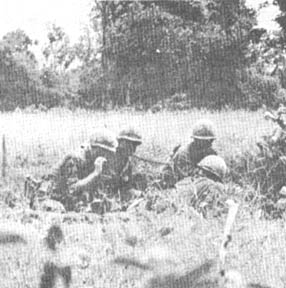 |
WAITING – A platoon RTO and command group of Company D, 2d Battalion, 12th Infantry, stop briefly in a concealed position while artillery and air strikes pound the enemy during fighting north of Cu Chi. (PHOTO BY SP4 CHARLES HAUGHEY) |
Tomahawks
Bag Bunkers
TAY NINH
- While on a sweep 12 miles east of Tay Ninh City, Company B, 4th Battalion
(Mechanized), 23d Infantry, found a large bunker complex with many military and
non-military articles spread throughout. The
number of bunkers, estimated to be more than forty, were all constructed with
overhead cover.
The strangest find made by
the Tomahawks was an American-made typewriter.
Near the typewriter were three cups of warm tea.
Somebody left in a big hurry. Whoever
it was left behind much that he didn’t want to leave.
In the same area one .45
caliber pistol was found along with an ammo box filled with military documents.
Shirts, pants, wet weather gear, sandals, and eating utensils were found
all over the area.
Located about 70 meters to
the west was a large covered hole that contained two five gallon tins of medical
supplies and several ponchos. Assorted
surgical instruments as well as pills and various types of bandage were in the
tins.
“This is one of the
largest bunker complexes that we’ve come across.
It’s certainly the most productive one that we have found in a long
time,” said Tropic Lightning platoon leader, First Lieutenant Jackie G. Reamy,
of Athol, Mass.
Manchus
Uncover Explosives
CU
CHI
—Following a day of heavy fighting, elements of the 4th Battalion, 9th
Infantry under the operational control of the 2d Brigade, uncovered a
significant cache of enemy supplies during operations five miles northwest of Cu
Chi.
Charlie Company squad leader
Specialist 4 Arnold R. Diekeme, Kent City, Michigan, first noticed fresh digging
near an abandoned enemy bunker. An investigation by Manchu soldiers revealed a
tunnel containing 76 Chicom bangalore torpedoes, 1,500 rounds of .51 caliber
machine gun ammo, 15 82mm mortars and fuses.
 |
TUNNEL RAT - Private First Class John Davidson, Sylacauga, Ala., is given a friendly assist as he passes a box of captured Chicom .51 caliber ammunition from a tunnel discovered by Charlie Company, 4th Battalion, 9th Infantry Manchus near Trung Lap. (PHOTO BY PFC H. J. TSCHIRNER) |
Page 4 TROPIC LIGHTNING NEWS January 6, 1969
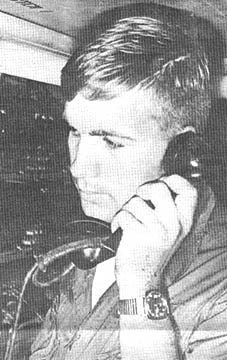 Division
Commo Is
Division
Commo Is
‘Voice Of Lightning’
CU CHI - From more than a
dozen fire support bases strung from Cu Chi to the Cambodian border, Tropic
Lightning’s interlocking fires relentlessly pound the jungle-shielded
insurgents.
But any fire is valueless
unless it can be applied quickly, anywhere over the large area of operations of
the Division. Calls for support
from field units must be communicated to fire support bases and base camps, and
target coordinates must be given; Tropic Lightning cannot strike blindly.
Linking all these posts is
the communications net of the 125th Signal Battalion, a unit organic to the
division. Through this net passes
not only tactical information and requests but also messages dealing with
supply, personnel, the processing of orders and all the many aspects of military
housekeeping for a division in combat.
The Hawaiian inscription of the 125th Signal Battalion, “Leokani
Okauwila,” means “Voice of Lightning.”
And being the voice of Lightning, the 125th has a mission of many phases
to perform. It provides
multi-channel voice and teletype communications among all echelons of
headquarters and major subordinate units.
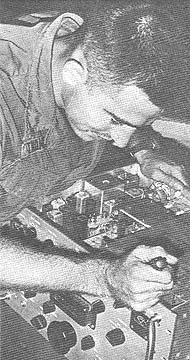 A three-man telephone switchboard, Tropic Lightning Main handles more
than 130,000 calls a month. Switchboard
workers stand two hours on and two hours off during their duty day.
A three-man telephone switchboard, Tropic Lightning Main handles more
than 130,000 calls a month. Switchboard
workers stand two hours on and two hours off during their duty day.
About 20 major signal MOSs
(military occupation specialties) are represented in the 125th Signal Battalion,
and training in school courses for the men of the 125th ranges from eight weeks
for linemen and operators to 40 weeks for those who will work in top-secret,
crytographic MOSs.
In addition to its
electronic communications net, the 125th with about 650 officers and men,
maintains the motor messenger service for the Division and supplies photographic
support for the Division’s activities. I.D.
card pictures are probably the most familiar product of the photographic lab.
One of the most crucia1 and
scenic points in the communications net is the 125th Signal relay station on Nui
Ba Den Mountain. Accessible only by
helicopter, weather permitting the station on Nui Ba Den picks up and relays UHF
and VHF signals.
When communications channels
must skip over contested territory, radio communications are in order.
In common use is a 12-channel set, each channel of which can be connected
to a telephone or teletype circuit.
The 125th Signal Battalion has its own maintenance shop for the
machines of the Tropic Lightning communications net.
The shop performs routine maintenance and replaces parts.
 The motto “Voice of Lightning” is but a clue to all missions and
functions of the 125th Signal Battalion. The 125th is the nervous system of a
fighting division carrying messages to all of its elements - and all of the news
is bad for Charlie.
The motto “Voice of Lightning” is but a clue to all missions and
functions of the 125th Signal Battalion. The 125th is the nervous system of a
fighting division carrying messages to all of its elements - and all of the news
is bad for Charlie.
But of course there is a
voice of lightning too. Doubters
may be persuaded by dialing ‘Operator’ on any Tropic Lightning telephone.
CHECK
– Communications team chief Specialist 4 George Stolgitis of Gilbertville,
Mass., makes a routine check of his part of the 125th Signam
Battalion communications net. (above, top right)
ADJUSTMENTS
– In the repair maintenance section of the 125th Signam Battalion,
Specialist 4 Larry S. Thomas of Sanford, N.C., finishes adjustments to radio
communications equipment.
(above, left)
WORKING
– Private First Class Ronald Schilitz of Washington Courthouse, Ohio, places
one of the 4,100 calls the Lightning Main switchboard handles every day.
(above, bottom right)
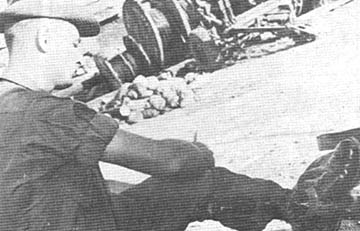 |
SUITING UP – Specialist 4 Phillip E. Newman, a lineman for the 125th Signal Battalion and former civilian lineman, gets into his climbing gear. Newman is from Clinton, N.C. (PHOTO BY SP4 ROBERT IMLER) |
Page 5 TROPIC LIGHTNING NEWS January 6, 1969
|
Lightning,
1st Air Cav MPs Combine Efforts TAY NINH - The 1st Platoon of the 25th MP Company assigned to the 1st Brigade, Base Camp at Tay Ninh West has been joined in its operations by the 1st platoon of the 545th MP Company assigned to the 1st Brigade of the 1st Air Cavalry Division. The joint operations came as a result of the 1st Cav’s recent insertion into War Zone C, with its 1st Brigade having its headquarters at Tay Ninh West. The 1st Cav’s 1st Brigade moved into camp in late October, 1968, and the two platoon leaders, First Lieutenant Morris W. Sills of Oreland, Pa., of the 25th and First Lieutenant John Smith of Dallas, Tex., of the 545th immediately joined forces to more effectively cover Tay Ninh City and Tay Ninh Province. On Post Patrol, gate activities, PX guards and other posts of mutual interest there is both a 25th and a 545th military policeman. Because of the joint operations, an additional town patrol has been added. Each town patrol consists of a 25th MP, a National Policeman and an interpreter. Tay Ninh City is off limits to military personnel. However black market activity, off limits violators, and the MSR from Cu Chi, Long Binh and Saigon to Tay Ninh West Base Camp give the town patrols more than enough work. The 545th shares the facilities of the 25th, with the platoon leaders maintaining a joint office. Sills of the 25th is the Tay Ninh West Base Camp provost marshal and Smith of the 545th is the assistant provost marshal. A joint blotter is maintained with information copies sent to the commanding officer of the 1st Brigades of both divisions. The two platoons eat in the same mess hall, sleep in the same hootches, and operate a club together for the use of the MPs only. “We’re awfully glad to have the 545th here,” said Sills,” to allow us to give the coverage to our area that it needs.” Smith, when asked, replied, “The 25th has one of the most professional operations I have ever seen and I’m very pleased that we (the 545th) have the opportunity to work with them.” |
|
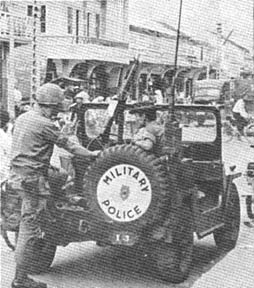 |
||||
| START OF A LONG DAY - The joint 25th MP/545th MP Town patrols in Tay Ninh prepare to move out. The two platoons joined forces to give better coverage to huge Tay Ninh Province when the 1st Brigade of the 1st Cavalry moved into the base comp at Tay Ninh West. (Below) | TOWN PATROL is conducted by the two MP companies. While the National Policemen and the 25th MP Company patrolman check out a building in downtown Tay Ninh City, Specialist 4 Harry W. Alfred of the 545th MP Company and Nguyen Thuong, an interpreter secure the vehicle. (Above) | ||||
|
 |
Page 6 TROPIC LIGHTNING NEWS January 6, 1969
Exchange
Student Gets Combat Degree
TAY
NINH
- It is a far cry from the ice-packed mountain peaks of San Moritz, Switzerland,
to the rice paddies of South Vietnam and a hard transition for anyone to make
But Sergeant Erich Morris of the 3d Battalion, 22d Infantry, has made the switch
in grand style.
The change in scenery was
quite apparent last August as Morris crawled forward through the defensive wire
at Fire Support Base Buell to rescue three members of his squad wounded while
manning a listening post. Even
though he exposed himself to a heavy volume of enemy fire, Morris saved his men
and received a Bronze Star for his gallantry in action.
Born in Switzerland and
educated in Germany, Erich moved to California about five years ago accepting an
opportunity to study in the United States as an exchange student.
Attending UCLA and later San
Francisco State University, he received his bachelor’s degree, and had planned
to attend the University of Heidelberg Medical School when the United States
Army entered the picture.
Actually, I had become a
citizen of the United States before I received my draft notice,” said Morris.
“It did come as somewhat of a shock, though because I had just received
my letter of acceptance from the University.”
In just a few short months
Morris was graduated from the NCO academy at Ft. Benning, Ga., and then to Ft.
Polk, La. for on-the-job training and then to the 25th Infantry Division in
Vietnam. Arriving at the 3d
Battalion, 22d Infantry, he immediately took up his post as squad leader.
In addition to earning the
Bronze Star, Erich received an Army Commendation Medal for helping to ward off
another abortive VC attempt to overrun his position at Fire Support Base Buell.
Erich leaves the service
when he returns from Vietnam and will join his wife Pam, also a former exchange
student, in Salinas, Calif.
Morris has expressed on
several occasions his feelings about serving in the Army of the United States
and has stressed the fact that he is very proud to wear the uniform.
“Pam and I are glad to do our part to serve our new country.”
CG
Presents Bronze Stars to RF-PF’s
By
1Lt. Mack Gooding
TAY
NINH
- In a recent ceremony held at Tay Ninh Province Headquarters, the Bronze Star
medal was presented to four Vietnamese soldiers by Major General Ellis W.
Williamson, commanding general of the 25th Infantry Division.
The awards were presented as
a result of action at Ben Cau ten miles south of Tay Ninh City.
During that action, the
Regional and Popular Force soldiers accounted for a 90 VC/NVA body count and
captured numerous weapons. They
were joined in the action by elements of the 1st Brigade.
General Williamson presented
the awards to Captain Nguyen An Ninh of the 146th RF Company, First Lieutenant
Le Ngoc of the 688th RF Company, Second Lieutenant Cong Loung Le of the 688th RF
Company and Second Lieutenant Doan Van Lang of the 251st Artillery Battalion (ARVN).
At the ceremony Colonel
Robert L. Fair of Alexandria, Va., commanding officer of the 1st Brigade, made
members of 164th and 688th Regional Forces companies honorary members of the 1st
(Lancer) Brigade. The new Lancers
were presented with pins bearing the 25th Infantry Division’s Insignia.
Four
NVA Regret Arrival Of Dragons
CU
CHI
– Golden Dragons from the 2d Battalion, 14th Infantry, recently
made a heliborne assault of suspected enemy positions near the Oriental River,
continuing their purge of enemy concentrations in the Duc Hoa area.
Elements of the 2d and 3d
platoons of Bravo Company were the first to make contact as pointman Private
First Class Alan W. Garrison spotted movement in a hedgerow to his right flank.
“I fired my M-79 into the
thicket, and as I did an NVA with a loaded RPG exposed himself,” reported
Garrison of Morgantown, N.C. “Before
I had a chance to reload, Private First Class James D. Munn, our machine gunner,
shot by me like a rocket, his sixty blasting away and cut him down,” Garrison
continued.
Action continued as flanker
Private First Class James E. Snook, Sacramento, Calif., approached a bunker
while the battalion’s Kit Carson scout, Van Chung Phan covered him.
“As he pulled off the
overhead cover an NVA in new web gear popped up and fired, wounding him,”
First Lieutenant Edward Morrow, Minneapolis, Minn. said.
“While the NVA was still firing, Chung and Private First Class James M.
Raves charged his position and the rest of the platoon moved up to help
Snook.”
A sweep of the immediate
area indicated that three of the enemy had been killed and one wounded.
The Tropic Lightning soldiers captured one RPG-7 launcher and two RPG-7
rounds, and five individual weapons.
 |
|
IT’S A HOT RICE FIELD – Men of Alpha Company, 2d Battalion, 27th Infantry Wolfhounds carefully search rice straw stacks for hidden munitions. The Tropic Lightning soldiers were on a sweep near the 2d Brigade’s Fire Support Base Reed. (PHOTO BY PFC R.B. WILLIAMS) |
VC
‘Bird Dogged’ By Arty, USAF
DAU
TIENG
- Air strikes and artillery nailed half a dozen enemy soldiers after they fired
on an Air Force spotter plane near Dau Tieng.
The pilot of the aircraft,
an O-1 Bird Dog, was circling above an enemy trail winding through elephant
grass west of the Michelin rubber plantation.
Just as Captain James J.
Hourin of Ellenville, N.Y., thought he spotted an enemy below, ground fire from
enemy rifles and machineguns came whizzing past the plane.
Hourin called in air strikes
from Tuy Hoa and Phan Rang as guns of Alpha Battery, 1st Battalion, 27th
Artillery began pouring 155mm howitzer rounds on the suspected position from the
base camp of the 3d Brigade at Dau Tieng.
After the smoke cleared
Hourin flew back in and spotted six enemy bodies below.
Page 7 TROPIC LIGHTNING NEWS January 6, 1969
The
Name Of The Game – Ingenuity
Story,
Photos By CPT Les Raschko
TAY
NINH
- Creating jobs in South Vietnam is a problem confronted by most province
officials. The Labor Office in Tay
Ninh recently came up with an idea to help solve their problem.
By using a waste product of war, jobs could be created, and the poor
people of Hiep-Anh hamlet would gain useful household appliances.
During early November, 1968,
Vo Van Sua and Le Thanh Cuu of the Tay Ninh Labor Office requested from the
civil affairs officer of the 1st Brigade, damaged 175mm powder canisters.
“I was a little
apprehensive at first, knowing that a metal canister can be made into weapons of
war. I was curious as to how they
could be made into implements of peace,” stated Major Clarence De Young from
San Diego, Calif., 1st Brigade civil affairs officer.
Vo Van Sua then proceeded to
explain to De Young the objectives of his request by showing him a stove he made
from a 175mm canister in early 1967. Sua
then demonstrated how one canister can be cut into two pieces, creating a base
and a top for a useful Vietnamese stove.
The stove will be used for
household cooking. The excess metal
could be used for drain pipes, construction pillars or metal sheeting.
Sua stated that he could hire 20 Vietnamese laborers through the Labor
Office and pay them with profits from the sale of the stoves on the open market.
Each stove will sell for 400
piasters ($3.40). The 400 piasters
will not only cover the laborers’ wages but pay for paint and the wick-filter
mechanism that each stove requires. The
wick-filter mechanism has to be purchased on the local economy. Many of the stoves will also be given to the poor of Hiep-Anh
hamlet.
“Their request showed much
planning and ingenuity,” commented De Young.
“The important thing was that they were helping themselves.
All they needed from us were the canisters. I was all for it.”
Permission to give damaged
canisters for this special purpose project was granted by USARV Headquarters in
late November, and in early December 1,343 damaged canisters wore picked up by
Tay Ninh Labor Office officials.
Of the 1343 stoves made,
approximately 800 stoves will be given to the poor of Hiep-Anh hamlet.
The other 543 will be sold to cover workers’ wages and material costs.
“In the near future we
plan to teach other villages throughout Tay Ninh Province the method of
converting damaged canisters into stoves,” said De Young.
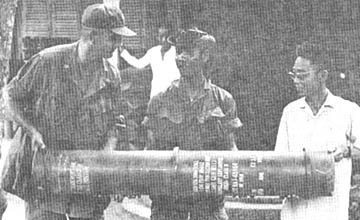 |
TOMORROW A STOVE – One of the 1,343 canisters donated to the Tay Ninh Labor Office, is handed to Pham Quoc Ninh (right), chief of Tay Ninh Labor Office, by Major Clarence De Young of San Diego, Calif., civil affairs officer for the 1st Brigade. Sergeant First Class Vo Vihn Luu (center), a Vietnamese interpreter for the 1st Brigade translates. Each canister is converted into one stove which used any combustible liquid. Creation of jobs and stoves for the poor are the Labor Office objectives. | |
| THIS YOUNG WORKER methodically hammers the cut out portion of the stove‘s top, thus molding the legs and grill work. | 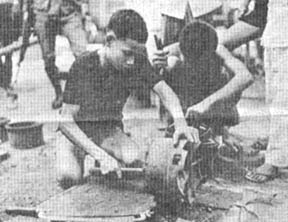 |
 |
LE DINH CUU, who is part of the Labor Office, spray paints part of the finished product using a home made spray gun. Pressure is created in the bicycle’s innertube by two young Vietnamese boys using air pumps, thus creating enough pressure to operate the spray gun. |
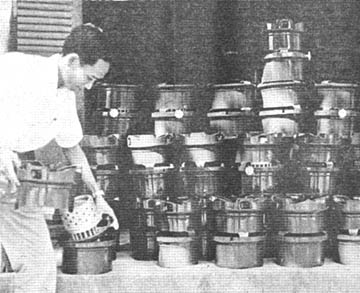 |
READY FOR MARKET – Le Dinh Cuu installs the wick mechanism into the base of the stove. Each stove will sell for 400 piasters ($3.40), which will cover the cost of the wick mechanism, labor and paint. |
Page 8 TROPIC LIGHTNING NEWS January 6, 1969
Forward
TOC At Tay Ninh Co-ordinates U.S., ARVNs
TAY
NINH
- Complete coordination, communications and understanding between the U.S. and
ARVN forces - that’s what has been effected through a forward Tactical
Operations Center (TOC) in the division’s northern area of operations.
‘Division Forward’ is
the tag given to the system at Tay Ninh East that coordinates Division plans and
operations with ARVN airborne units and ARVN Special Forces.
According to Captain Charles
E. Mehring, of Lawton, Okla., assistant operations officer, “Division Forward
provides the field commander, that is, the assistant commander of maneuvers,
Brigadier General Glen C. Long, a forwardmost post near the action.”
Mehring described it as an
extension of Division Headquarters, referring to the Tay Ninh City TOC as a
‘field headquarters’ for General Long.
By having a communications
center within an ARVN compound, Mehring said it is “possible for us to relay
any and all intelligence and operational information to the division main,”
thereby providing immediate knowledge to decision makers at division level.
Sergeant Donald A. Bosworth,
of Pasadena, Calif., added that Division Forward aids in the support of ARVN
units in the Division’s area of operations, and that a more effective liaison
between U.S. and ARVN troops is accomplished.
The idea for a forward TOC
materialized during the Battle of Tay Ninh in mid-September last year, when
enemy troops had the intention of capturing and holding Tay Ninh City.
“They failed miserably,” the Captain said tersely.
‘‘Our success,”
explained Captain Ray Kirkpatrick, communications officer from Newark, Del.,
“is contingent on our complete communications system to all units and
brigades.”
Kirkpatrick mentioned
Division Forward implements a system of telephone, radio and land lines to
maintain direct contact with the brigades of the division, the 1st Air Cavalry
Division, and ARVN Special Forces and Airborne units in the field.
Secure radios used to
discuss classified information are set up at Division TOC in Cu Chi base camp
and Tay Ninh East. The radio system
also forms a communications net for the liaison officer at the 1st ARVN Airborne
Brigade.
Nui Ba Den, the lone, huge
mountain jutting from the flat land in Tropic Lightning’s area of operations
north of Tay Ninh is a valuable and essential communications link, according to
Kirkpatrick. He said all communications from the area to Division headquarters
depend on the mountain.
Sergeant Jerome Pellerin, of
Bennington, Vt., communications NCO, noted that the entire TOC, complete with
all equipment could be totally dismantled, transported to another location, and
set up again in three to five hours. He
emphasized the mobility of the entire Division Forward operation.
A typical day’s work,
according to Mehring, includes “first and foremost, security of all roads in
the division’s area.” It is the
responsibility of the forward TOC to keep maps and charts current on progress of
mine sweeps. Any significant finds
or presence of enemy is related immediately to Division level, so action can be
taken.
“We also coordinate
extensive heliborne operations combined with ARVN forces within the Division,”
explained Mehring. On one particular day, the Division Forward TOC was
instrumental in having one ARVN and two U.S. companies airlifted into enemy
territory in War Zone C. Their
purpose was to frustrate VC and NVA attempts at establishing base camps and
resupply points in that area.
Communications is important
in coordinating combined efforts with ARVN units in heavily populated areas.
“Our purpose is to help the Vietnamese people through civil affairs and
psychological operations and medical-civic actions programs,” noted Mehring,
“and we’re helping them help themselves through better coordination.”
Also there is daily liaison
with ARVN Special Forces Headquarters in Tay Ninh East, where there is a mutual
exchange of valuable tactical information.
Each day Tay Ninh province chief Colonel Nguyen Quang Thong is briefed on
the day’s operations. “This
helps immensely in coordinating U.S. and ARVN forces in the field,” said
Mehring moments after he had briefed the province chief.
Major Aubrey J. Holloway,
assistant operations officer in the Division TOC at Cu Chi Headquarters,
explained that the Tay Ninh TOC’s primary function is to keep up-to-the-minute
track of ARVNs, Special Forces and 1st Air Cavalry forces which border the
division’s area.
Looking at the operation
from the division point of view, Holloway, a native of Atlanta, gave an example.
“Say the ARVNs decide they want to put a 250-man force into our area of
operation. They would first check
with Tay Ninh’s Division Forward, which would then check with us.
This way we know exactly where everyone is, and avoid duplication of
effort and mixups in the field.”
If a tactical maneuver
originates with Division Headquarters, the information goes immediately to Tay
Ninh, is mapped, and all concerned units are notified.
Holloway said, “This
co-location with ARVNs and the eye-ball-to-eyeball contact is unbeatable.”
He concluded that now there is an “untold improvement in the smoothness
of the U.S. and ARVN combined operations in the division.”
|
Story And Photos By SP4 Jim Brayer |
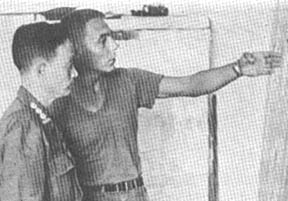 |
PROVINCE CHIEF BRIEFED - Captain Charles E. Mehring of Lawton, Okla., assistant operations officer of division Forward briefs Colonel Nguyen Quang Thong, Tay Ninh’s Province chief, on military operations in the Tropic Lightning’s AO. | |
| Lieutenant General Do Cao Tri, commanding general of III Corps Headquarters, points out to Brigadier General Glen C. Long, assistant division commander for maneuver, where one ARVN battalion is located. Major General Nguyen Xuan Thinh, commanding general of the 25th ARVN Division, looks on. | 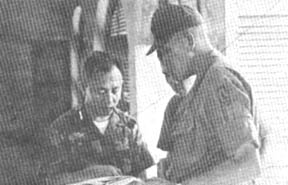 |
Distinguished
Service Cross Presented To Two Captains
 Captain Robert A. Snyder of the 7th Battalion, 11th Artillery and Captain
Gerald J. White of the 3d Battalion, 22d Infantry, have been awarded the
Distinguished Service Cross for valor.
Captain Robert A. Snyder of the 7th Battalion, 11th Artillery and Captain
Gerald J. White of the 3d Battalion, 22d Infantry, have been awarded the
Distinguished Service Cross for valor.
While CPT Snyder was serving
as Battery Commander, the enemy attacked Fire Support Base Buell II. Though
wounded, he led and encouraged his men.
CPT White was serving as
Company Commander of D Company, when the enemy attacked his perimeter. He
organized his wounded into a reactionary force, and repelled the enemy.
General Creighton W. Abrams,
COMUSMACV, presents the award to White (right) and Snyder (below) at fire
support base Buell II. (PHOTO
BY MAJ A. J. SULLIVAN)
 |
Thanks to
Mack D. Gooding, 15th PID, 1st Bde., for sharing this issue,
Kirk Ramsey, 2nd Bn., 14th Inf. for creating this page.
This page last modified 8-12-2004
©2004 25th Infantry Division Association. All rights reserved.